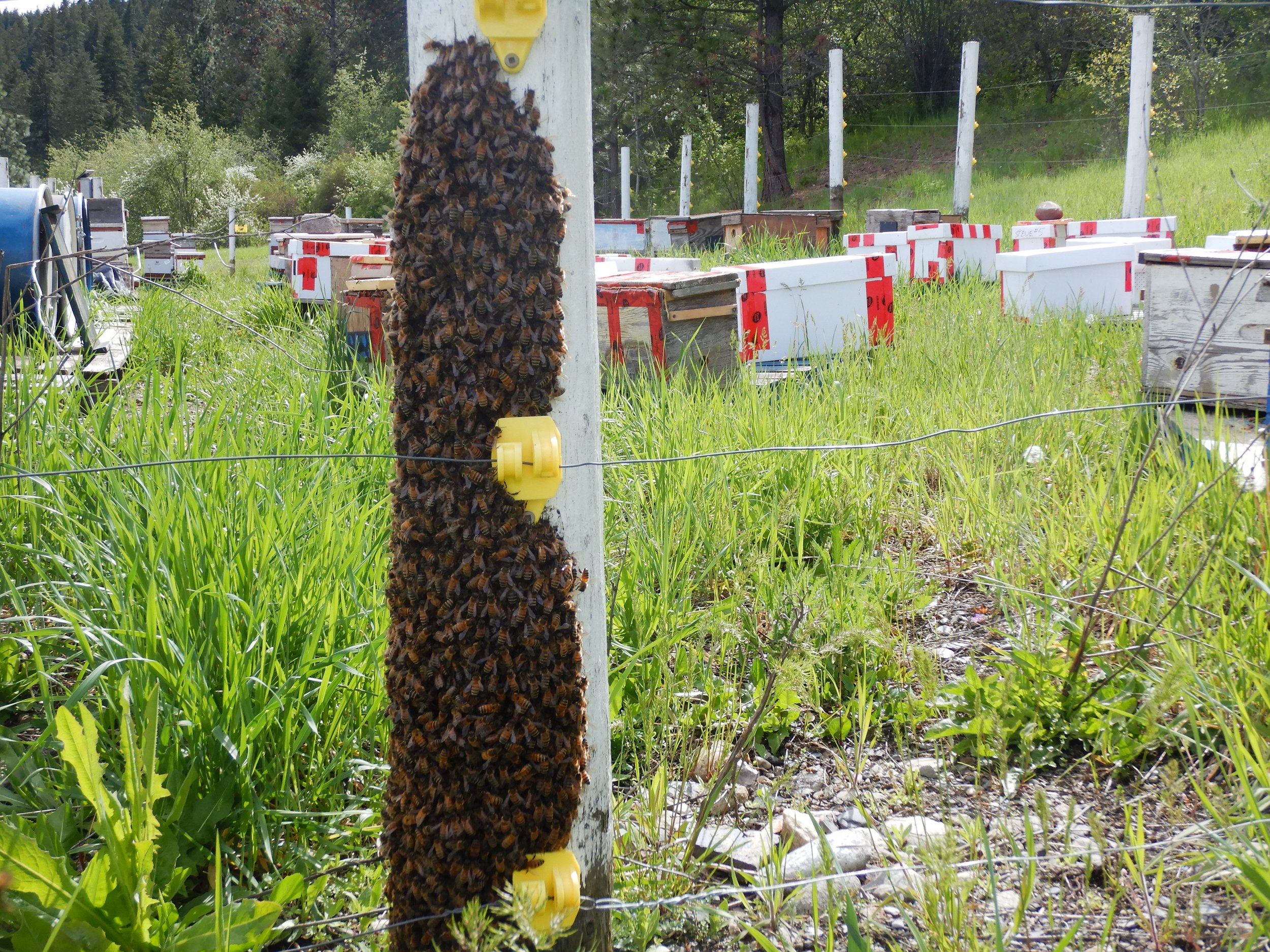Swarm Control
March 2025
By Leilani Pulsifer
Swarming is a honey bee colony’s natural way of splitting a hive once the population becomes too large. This behaviour is triggered by an increase in resources such as nectar and pollen that causes honey bees to rear brood. As the population of the colony increases, there is a decrease in the distribution of queen pheromone around the colony, and this leads to worker bees rearing more queens. Following the promptings of the workers, the mother queen along with approximately half of the workers in the colony will leave the hive all at once and settle nearby in its own cluster.
A swarm of honey bees gather on a fence post near its original hive.
When does swarming occur?
Since swarming relies on resource availability, it typically happens around the nectar flow when resources are abundant. In British Columbia, swarming is expected during the months of April to May. Swarms typically emerge between 11AM and 1PM when temperatures are warmest but is weather and resource dependent.
Signs of swarming?
Swarms occur in response to an increase in population size, lowered distribution of queen pheromone, signals from other bees and hormones within their own bodies. This results in a range of signs and events leading up to a swarm that you can keep an eye open for:
A rapid expansion of a colony’s population in the spring.
Solid brood pattern.
Queen rearing (15-25 queen cells).
Existing queen receives less food and loses weight to be able to fly to a new location.
Scout bees find the best possible nesting site as quickly as possible.
Worker bees push and bite the queen to force her to fly to the new location.
Worker bees consume an excessive amount of honey in preparation for taking off with the old queen.
How to prevent swarming?
The best way to prevent (or delay) swarming is to keep your bees from rearing queen cells. Here are some preventative measures you can take to controls swarms:
Provide plenty of room for queen egg laying in the brood nest.
Provide sufficient space for nectar storage.
Maximize sunlight early in the season but provide shade when temperatures increase later in the season.
Provide sufficient ventilation.
Head all colonies with young queens.
Remove queen cells as they are formed.
A queen cell.
If queen cells have already formed:
Remove the queen: she can be returned or replaced after the queen cells have been removed.
Divide the colony: this solution mimics swarming but keeps it under your control! Remove 3-5 frames of brood and create a nucleus hive with a queen cell or a new queen.
How to manage a swarm?
Oftentimes in beekeeping, things don’t go exactly according to plan. If a swarm occurs, don’t panic! Here are some tips on what to do next:
Allow the swarm to cluster for at least 30 minutes.
If possible, locate and cage the queen.
Place a hive with frames, a bottom board, and a lid nearby the cluster and if you have successfully caged the queen, place her in the empty hive.
Move the majority of the swarm into the hive.
Leave the hive for the remainder of the day to allow the remaining bees to enter before moving the hive to a permanent location.
Monitor the colony after a week, then every 2 weeks from May to late June - look for diseases (including AFB and varroa mite levels), brood abundance, pattern and overall quality of the colony.
At times it can seem like scout bees choose the most inconvenient place for the swarm to cluster – stories high in a treetop, hollows of trees, even the inside of chimneys or walls! If that happens and you’re unsure of how to reach the colony, reach out to a local bee removal service if possible and they will have the necessary tools to collect the swarm. If that’s not a possibility, ask your local beekeeping community for help! For a list of beekeeping clubs in British Columbia, click here: Get Involved.
///
We hope this article has helped you feel more prepared for swarm season! As always, if you have any questions about swarming or any other honey bee inquiries, please reach out to us via email (info@ttp-bchpa.ca), Instagram (@BC_TTP), or Facebook (@BC Tech Transfer).
References
BC Ministry of Agriculture. (2015). Swarming (404). https://www2.gov.bc.ca/assets/gov/farming-natural-resources-and-industry/agriculture-and-seafood/animal-and-crops/animal-production/bee-assets/api_fs404.pdf
Caron, D. M. (2000). Swarming - control. MAAREC, 3.4. https://canr.udel.edu/maarec/wp-content/uploads/sites/18/2010/03/Swarm_Prev_Control_PM.pdf
Passino, K. M., Seeley, T. D., & Visscher, P. K. (2008). Swarm cognition in honey bees. Behavioral Ecology and Sociology, 62(3), 401-414.






